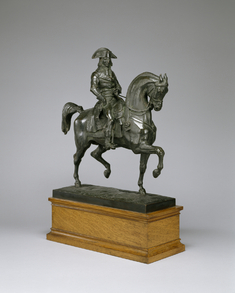Napoleon I
(18th and 19th Centuries )
Barye was commissioned by the city of Grenoble, France, to produce an over-life-size sculpture of Napoleon I seated on a horse. The statue, which was never completed, was intended to commemorate Napoleon's arrival there in March 1815 upon his return from a brief period of exile on the island of Elba. Entering the town, the emperor bared his chest to the soldiers stationed there and demanded that they either shoot him or let him pass. The troops enthusiastically welcomed him, but after his defeat at the Battle of Waterloo, he was sent to the island of Saint Helena off the coast of Africa, where he died in 1821.
Provenance
Provenance (from the French provenir, 'to come from/forth') is the chronology of the ownership, custody, or location of a historical object. Learn more about provenance at the Walters.
William T. Walters, Baltimore [date and mode of acquisition unknown]; Henry Walters, Baltimore, 1894, by inheritance; Walters Art Museum, 1931, by bequest.
Exhibitions
| 2007-2008 | Untamed: The Art of Antoine-Louis Barye. The Walters Art Museum, Baltimore; Philbrook Museum of Art, Tulsa; The Henry Morrison Flagler Museum, Palm Beach. |
Geographies
France, Paris (Place of Origin)
Measurements
H: 17 11/16 x W: 14 in. (45 x 35.5 cm)
Credit Line
Acquired by William T. Walters, before 1894
Location in Museum
Not on view
Accession Number
In libraries, galleries, museums, and archives, an accession number is a unique identifier assigned to each object in the collection.
In libraries, galleries, museums, and archives, an accession number is a unique identifier assigned to each object in the collection.
27.163



